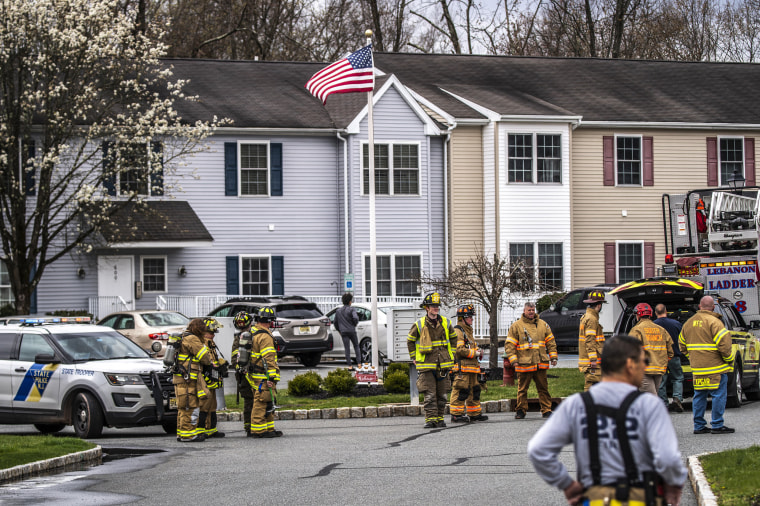The fault that ruptured beneath New Jersey on Friday morning was probably an historical, sleeping seam within the Earth, woke up by geologic forces in a area the place earthquakes are uncommon and seismic dangers will not be totally understood.
The magnitude-4.8 earthquake was the strongest in New Jersey in over 200 years.
America Geological Survey mentioned in a information convention that extra earthquakes are attainable, with statistical modelers estimating a 3% likelihood of an earthquake of magnitude 5 or larger within the coming weeks.
A 4.0-magnitude aftershock struck New Jersey on Friday night. The USGS web site has reported at least 11 aftershocks within the space to date. Statistical fashions based mostly on previous earthquakes instructed there could possibly be as much as 27 aftershocks of magnitude 2 or better over the following week, the USGS mentioned.
Because the shaking calmed on Friday, scientists started working to pinpoint the place precisely the rupture occurred.
“It is a area with many older faults that could be reactivated at any time. At the moment, the fault that brought about the earthquake isn’t but recognized,” mentioned Jessica Jobe, a USGS analysis geologist.
Scientists suspect that the earthquake probably originated within the space of the Ramapo fault zone within the Newark basin. The fault system accommodates a branching community of faults. Some are mapped however others are most likely unknown, so it’s attainable that the fault the place the Friday quake occurred is unmapped.
“It probably occurred on an unnamed fault, however we actually don’t know. It’s laborious to determine that out in a spot that has such a jumble,” mentioned Dara Goldberg, a USGS geophysicist. “It could possibly be on a department of a Ramapo fault. It could possibly be one thing adjoining, we’re not precisely positive.”
Scientists mentioned the fault zone is outdated and sophisticated. Figuring out exactly what occurred will assist researchers perceive what to anticipate from the zone sooner or later and get a greater deal with on seismic threat within the Northeast.
In contrast to the West Coast, the place tectonic plates meet at a boundary and create a seismic hazard that runs down the backbone of the coast, the Northeast’s tectonic threat is rooted in historical historical past: Faults have persevered from tectonic processes which might be now not in motion, leaving a scattering of cracks and weaknesses.

Stress accumulates slowly on this community of faults and typically causes a slip, producing an earthquake, mentioned Frederik J. Simons, a professor of geosciences at Princeton College.
“The stress retains rising at very sluggish charges,” Simons mentioned. “It’s like an outdated home creaking and groaning.”
In comparison with the West Coast, earthquakes on the East Coast might be felt at an awesome distance and might trigger extra pronounced shaking relative to their magnitude as a result of rocks within the area are sometimes older, more durable and extra dense.
“These are competent rocks that transmit power properly,” Simons mentioned.
Friday’s earthquake was felt broadly, from Washington, D.C. to Boston. It was additionally fairly shallow — the USGS mentioned it probably ruptured lower than 3 miles beneath the Earth’s floor.
“The shallower or the nearer it’s, the extra we really feel it as people,” Simons mentioned.
Nevertheless, the energy of earthquakes within the area is proscribed by the size of the faults.
“The magnitude of an earthquake is immediately proportional to the size of the fault that moved,” Goldberg mentioned. “Within the Northeast, the faults simply aren’t very lengthy.”
Felix Waldhauser, a seismologist and analysis professor on the Lamont-Doherty Earth Observatory, mentioned the earthquake highlighted a necessity to raised perceive the area’s earthquake threat.
“We don’t perceive the faults right here very properly. If we don’t perceive the faults, it’s troublesome to evaluate the hazard,” Waldhauser mentioned.
He lamented the truth that the USGS in 2019 reduce funding for the Lamont-Doherty Cooperative Seismographic Network, which he mentioned as soon as had 45 stations gathering seismic knowledge throughout the Northeast however is now all the way down to about 20.
“In a really perfect world, we’d have our community operating and recording knowledge and analyzing the info, determining the place precisely the occasion was,” he mentioned.
Waldhauser mentioned on Friday afternoon that he was attempting to spherical up colleagues to deploy seismometers across the epicenter of the earthquake, close to Whitehouse Station, New Jersey, to document aftershocks, which might assist determine the principle fault line.
“We’re attempting to get individuals collectively. I’m undecided if it’s going to occur,” he mentioned.
Nevertheless, Goldberg mentioned {that a} dense native community of apparatus is most helpful for monitoring smaller earthquakes and conducting detailed science, however isn’t a requirement to know bigger quakes just like the one on Friday.
“Something within the magnitude 4 vary, we will decide in a world set of stations,” she mentioned. “For the dimensions of earthquakes related to society and other people’s day by day lives, we will do a nice job with out that density.”
Simons, who grabbed his coat and hurried out of his Princeton workplace when the earthquake hit, mentioned the 35 seconds of “violent, sturdy and lengthy” shaking made for an thrilling morning and provided a reminder to the nation’s much less seismically lively coast: “That is like being slightly out of form and having slightly warning — a mini-stroke, a coronary heart assault,” he mentioned.
“The Earth is giving us power we will’t management. Let’s proceed to construct good buildings and implement constructing codes and do catastrophe prep, so we will reply when the following one hits,” Simons mentioned.




